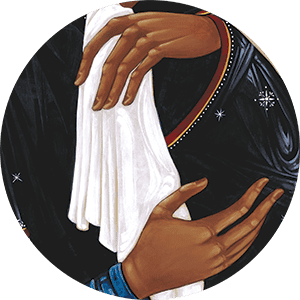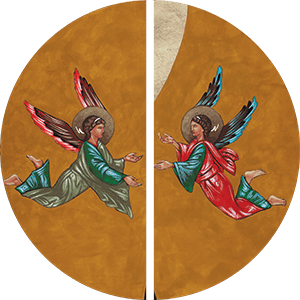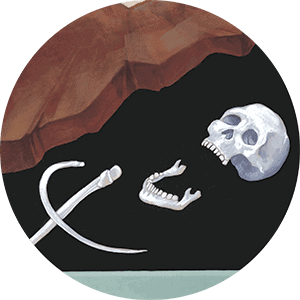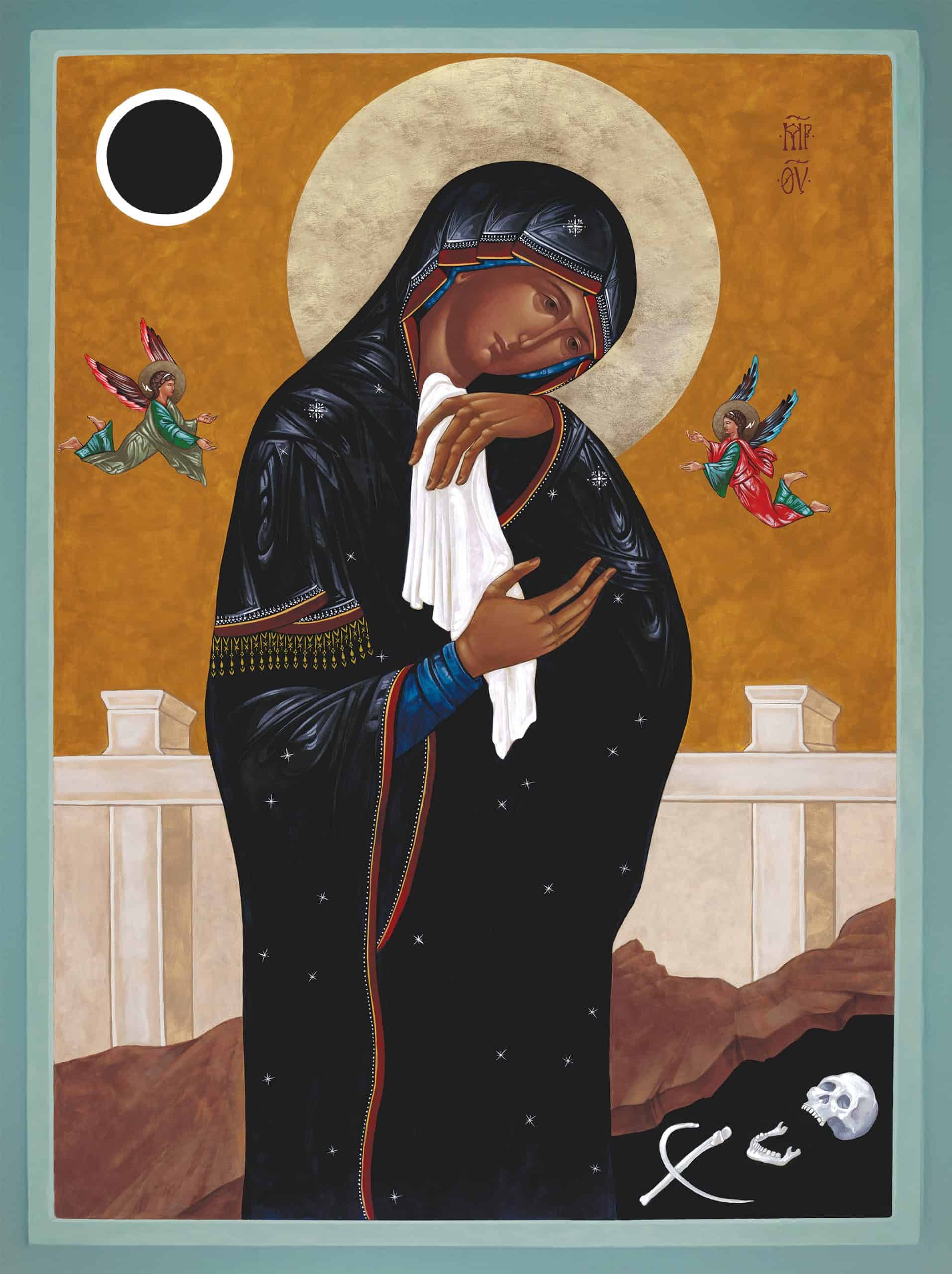MARCH 2025 PASTORAL NOTE
Standing with Mary at the Foot of the Cross
Every Lent leads to the same mystery: the Crucifixion, Death and Resurrection of our Lord, Jesus Christ. Every Lent prepares the Church and all her members to experience and participate more profoundly in the Paschal Mystery. It is a season of purging our souls of sin and disordered attachments to become more like Jesus. We believe with St. Paul that “If we have died with Christ, we will also live with him” (Rom 6:8). It is a season where we set our gaze on the cross of Christ and place our hope in his resurrection.
Last year, in 2024, my team and I recognized that we were approaching the 2000th anniversary of the Paschal Mystery in 2033. Pope Francis announced that the Church will celebrate an Extraordinary Jubilee for this incredible occasion. In preparation for the great Jubilee of 2033, I am announcing a nine-year novena. To lead and accompany us toward the 2033 Jubilee, I have chosen to direct the novena to the Blessed Virgin Mary under the title “Mary at the Foot of the Cross.” As Mary was present with Jesus throughout his passion, she will guide us in meditating upon these mysteries and participating in Jesus’ salvific mission on the cross. While my team and I began invoking Mary’s intercession under this title last year, I feel Ash Wednesday of this year is the best time to invite the whole archdiocese to join us in the novena.
The concept of a nine-year novena is not unprecedented, especially here in the Archdiocese of Denver. As we approached the great Jubilee in the year 2000, then Archbishop Stafford proclaimed a nine-year novena to prepare to celebrate 2,000 years since the Incarnation of Jesus. To support the novena, he commissioned an icon of Our Lady of the New Advent. I am pleased to reveal the icon commissioned for this novena, Mary at the Foot of the Cross.
The Icon
For centuries, icons have communicated the richness and beauty of the Church’s story. They contain much symbolism and assist us in praying with and entering more deeply into the mysteries of Jesus’ life. Our icon, as well, is rich in beauty and symbolism. I am grateful to Elizabeth Zelasko, an artist of our archdiocese, for sharing her gifts in writing the icon and explaining its unique features.
Mary’s Hands
Many icons throughout the history of the Church have portrayed Mary with her hands in this posture while at the foot of the Cross. At her son’s death, she remembers holding him as an infant in her arms, but now her arms are empty. She holds the swaddling cloth she has saved all these years from his birth.

Two Angels
Angels were present in the lives of Jesus (Mt 4:11, Lk 22:43) and Mary (Lk 1:26) throughout the Gospel, and two are shown in the icon ministering to Mary at this moment of great suffering.

The Stars
The stars on her cloak are a nod to Our Lady of Guadalupe and to Revelation 12:1, which reads, “A great sign appeared in Heaven: a woman clothed with the sun, with the moon under her feet, and on her head a crown of twelve stars.” 1
It is traditional to feature three brighter stars on Mary’s head and shoulders that point to her virginity before, during, and after the birth of Christ.

“MP θV”
The “MP θV” in the upper right-hand corner is the Greek abbreviation for “Meter Theou” or “Mother of God.” The lines over the letters show that the name is an abbreviation.

The Bones
It is held in our tradition that Jesus was crucified on the same place where Adam, the first man, was buried. Adam’s bones are often shown at the foot of the Cross. In this icon, his bones are crossed to form an “XC,” which is the Greek abbreviation for Christ. The crossed bones are made up of his rib, pointing to the creation of Eve and to Mary as the “New” Eve, and his forearm bone (the ulna), with which Adam would have reached out to grab the fruit from the tree of knowledge.

The Walls
The walls of Jerusalem are in the background, recalling that Jesus was crucified outside of the city walls (Heb 13:12).

The Eclipse
In Luke’s Gospel, we read: “It was now about the sixth hour, and there was darkness over the whole land until the ninth hour, while the sun’s light failed. And the curtain of the temple was torn in two” (Lk 23:44-45). Many icons show “the darkness” as an eclipse, which is shown in the upper left corner. The sky around the eclipse is a darker shade to emphasize this moment. Mary’s dark veil against the gold halo also echoes the shape of the eclipse.

If you would like to purchase prints of the icon to pray with during this nine-year novena, please visit Elizabeth’s website:
elizabethzelasko.com
Standing with Mary at the Foot of the Cross
This Lent, as we look toward Good Friday and the Great Jubilee in 2033, we recognize that no one knows this journey better than the Mother of Jesus. The Collection of Masses of the Blessed Virgin Mary captures this beautifully in the introduction to the Mass celebrated under the title, “The Blessed Virgin Mary at the Foot of the Cross.” It reads, “Lent unfolds like the journey of Jesus to the holy city of Jerusalem, the place of his sacrifice: as it progresses, there is more frequent meditation on the mystery of his Passion. So too in the hearts of the faithful there is more frequent remembrance of the compassion of our Lady.” 2
Mary stood at the foot of the Cross as Jesus suffered, taking upon himself the sin of the world, and anticipated the moment when he would ultimately put sin to death when he breathed his last. As she did at the beginning of Jesus’ life, Mary “treasured up all these things, pondering them in her heart” (Lk 2:19). She continues to bless the Church every Lent by sharing the treasures of her heart from these hours at the foot of the Cross. Mary is a model of hope, perseverance, and contemplation as we seek to understand and be transformed by the saving actions of Jesus.
In this Lenten Pastoral Note, I desire to call our attention to Jesus’s seven last words spoken from the Cross. I invite you to receive them with Mary, to contemplate them in your heart with her, and be open to how Jesus calls you to prepare for the celebration of the Paschal Mystery in the Holy Triduum.
1. Father, forgive them, for they know not what they do. (Luke 23:34)
Jesus intercedes for all sinners from the Cross. As high priest, offering himself as the sacrifice, he begs for the Father’s mercy and offers prayers of reparation for sin. Following Jesus’ example, Mary offers prayers for reparation for our sins and the sins of others. We, too, are called to join in these prayers to complete in our own way “what is lacking in Christ’s afflictions for the sake of his body, that is, the church” (Col 1:24). During this novena, I highly encourage my brother priests to offer Masses of reparation.
As indicated above, the title, “Mary at the Foot of the Cross” is a direct reference to the title of Mary invoked in the Collection of Masses of the Blessed Virgin Mary, numbers 11 and 12. Specifically, in number 12, the introduction points us to Mary’s redemptive suffering and her role in making reparation for sin at the foot of the Cross: “There she did not spare her own life when her nation was brought low; she endured the greatest of pains in bringing forth to new and divine life the family of the Church… hence the faithful glorify her as they say, ‘How blessed was the Virgin Mary in her sufferings: she gained the palm of living martyrdom at the foot of the Cross of her Son.’” 3
Mary suffers with Jesus and prays for all of us. The Church has continued to call upon Mary as she shares in her Son’s mission to make reparation for sin. Hence, in the Hail Mary, we ask Our Lady to “pray for us sinners, now and at the hour of our death.” In appearances at Fatima, both the Angel and the Blessed Virgin Mary stressed the need for reparation and taught the children to pray for reparation. 4
At every Mass, during the penitential rite, we can confess both our personal sins and those of the world. Often at Mass, I ask forgiveness for the sins of the world that undermine the love of the Father and the dignity of the human person. Sins such as, though not limited to, lack of faith, hope, charity, trust in Jesus, for those who promote war, genocide, murder, abortion, euthanasia, human trafficking, sex trafficking, drug trafficking, racism, transgenderism, exploiting the poor and homeless, adultery, promoting sexual acts outside of the marriage of husband and wife, and many others that are known to Jesus alone.
The need for the work of reparation for sin has been a constant theme received in prayer from my intercession team and in my own prayer. I invite all the faithful to offer prayers of reparation. In a special way, I invite my brother priests to offer these Masses to the Blessed Virgin Mary at the Foot of the Cross for the reparation of sins on ferial days and Saturdays in these nine years, as well as Masses for the Forgiveness of Sin in the Roman Missal, leading up to the Jubilee in 2033.
All the faithful are encouraged to join in our reparation effort. I offer four simple options to participate:
- Find out when your parish will celebrate the Masses to Mary mentioned above and attend Mass.
- Pray the Chaplet of the Holy Face of Jesus, which we have promoted throughout the Eucharistic Revival.
- Pray the Rosary, especially the sorrowful mysteries of Tuesdays and Fridays.
- Make a daily conscious offering of every good deed to the honor and glory of the Father out of charity.
2. Women, behold your son… behold your mother. (John 19:26-27)
At the foot of the Cross and by the command of the Lord Jesus, the Apostle John received Mary into his home as his mother. John represented the whole Church at that moment, and all of us received the divine gift of having Mary as our mother. As we contemplate Jesus’ Passion, this is a moment to receive anew the gift of Mary’s maternal care for each one of us. Mary is our mother who loves us and wants to bring us closer to her son, Jesus and to the Father and Holy Spirit. Her tender love for humanity is seen in her apparitions through the centuries.
Mary is not only a mother to us in the way she cares, protects, and nurtures us. She is also the mother of our salvation and life of grace. God chose her to receive the seed of his word, which would become the great vine in John 15, which gives eternal life and bears fruit through all who abide in him and keep their eyes and hearts fixed on Jesus. Being grafted into the vine is to be born from the womb of Mary, who is our mother.
3. Today you will be with me in paradise. (Luke 23:43)
Mary watched as Jesus promised a thief, “Today you will be with me in paradise.” There is quite a contrast between the thief, whose crimes merited the punishment of death, and the Immaculate Virgin, who has never once stepped outside of the full grace of God. Yet, Mary does not resent the reward promised to the thief by her son; she rejoices in it. Beyond rejoicing, Mary, now the mother of all, participates in Jesus’ mission by spiritually adopting the thieves and even the sinners responsible for putting her son to death.
Mary is a woman full of hope. Real hope changes our hearts so that our desires become God’s desires, and we become who God created us to be. There is nothing Mary wanted more in that moment than the will of the Father to be accomplished for the thief and for herself. Mary now shares in the fullness of the resurrection in her Assumption into Heaven.
Our current Jubilee in 2025 is a Jubilee of Hope. Let us ask Mary to change us at the foot of the Cross to be men and women of hope. We will know that we are growing in hope when we want the true good for our enemies, not their destruction or humiliation. Growing in hope is a process closely tied to forgiveness and mercy.
I came to a deeper awareness of the relationship between hope, forgiveness, and mercy on a recent visit to the extermination camp, Auschwitz, where I became more familiar with the story of Rudolf Höss. Rudolf Höss is most famous for serving as the commandant of Auschwitz. Previously, he served in World War I, and after Germany’s defeat, he joined the Nazi party when he was 21 years old. At the same time, he renounced the Catholic faith in which he was raised. Eventually, he became a member of the SS and earned a position of significant responsibility.
After his country’s defeat in World War II, Höss was captured and put on trial for war crimes. In his testimony, he estimated that he had overseen the mass murder of around three million people at the extermination camp. 5He was sentenced to death by hanging. After the sentencing, Höss requested to speak to a priest. They had a difficult time finding a priest who would agree to hear the Confession of a man who had committed such heinous crimes. Höss had imprisoned and killed several priests at Auschwitz, including St. Maximilian Kolbe. But he remembered the name of a Jesuit priest in particular who had snuck into the camp to be with his brother Jesuits who had been imprisoned. Höss was so impressed with the priest’s courage to sneak into Auschwitz that he released him and sent him away. 6 He asked for that priest to be summoned to hear his Confession.
The priest, Father Władysław Lohn, was found in Krakow praying at the Shrine of Divine Mercy. 7 Upon hearing the request, Father Lohn traveled to the prison and heard Rudolf Höss’ Confession. In between Rudolf Höss’ Confession and his execution, he wrote letters to his wife and the nation of Poland repenting of his actions, admitting that he was wrong in committing himself to the Nazi ideology, and professing that he had found his faith again and that God had forgiven him.
On the day of Rudolf Höss’ death, he awaited his execution in a cell in Auschwitz. It was the same cell where he kept and starved St. Maximillian Kolbe to death. From that very cell, it is likely that St. Maximillian prayed for Rudolf Höss’ conversion.
One thing is clear through Höss’ story of conversion: no one’s sins are too far out of reach for the mercy of God. Jesus offers us hope from the Cross that his mission and plan of salvation will be fulfilled. Mary is the living example of God’s plan fulfilled. In every apparition, we see a human being in love with the Trinity, who, through grace and charity, lives in paradise with Jesus. This, too, is real for us as well. Jesus’ sacrifice on the cross has opened the way and given us every opportunity to repent, believe and follow him into Heaven.
4. My God, My God, why have you forsaken me? (Matthew 27:46)
In standing with Mary, we see how her heart was pierced in fulfillment of the prophecy of Simeon (Lk 2:35). There are times when Mary felt forsaken. We all, as humans, feel forsaken or abandoned at some point, but we trust in hope that the Lord is with us (Ps 22). We must remember that Mary’s feeling of abandonment comes because of her decision to align her life completely with her son Jesus. She shares in Jesus’ suffering as he takes the sin of the world upon himself. In meditating on these words of Jesus, we are reminded of the cost of discipleship.
While false prophets and teachers would tell us that life with Christ will bring health and wealth, we know that following Jesus leads us to one place: the Cross. Jesus taught, “‘A servant is not greater than his master.’ If they persecuted me, they will also persecute you. If they kept my word, they will also keep yours. But all these things they will do to you on account of my name, because they do not know him who sent me” (Jn 15:20-21).
It is only in and through the Cross that we enter Heaven. Mary shows us this by her example at the foot of the Cross. We are to offer our lives to the Father as Jesus offered his. “Greater love has no one than this, that someone lay down his life for his friends” (Jn 15:13). In every Mass we celebrate this truth. As we join our lives to Jesus’ one sacrifice on the Cross, made present in the Mass, the Paschal Mystery is personally accomplished for each of us. In this year of Jubilee, let our hope in the triumph of the Cross overcome our fear of the challenges and sufferings that come with being a disciple of Jesus. Though we may feel abandoned, God is with us as he has promised, “Know that I am with you always…” (Mt 28:20).
5. I thirst. (John 19:28)
We understand, as the Missionaries of Charity do, that when Jesus says, “I thirst,” he thirsts for souls. He thirsts for us and every human being. In the book of Hebrews, we read that Jesus, “for the joy that was set before him endured the Cross” (Heb 12:2). We are that joy. Jesus longed for the day that we would be with him in paradise, and he expresses this in these two simple words: “I thirst.”
Mary shares in that thirst for souls when standing at the foot of the Cross with Jesus. We know this to be true from all her apparitions. In a particular way, I recognize in Mary’s apparition to St. Juan Diego her thirst for souls. As millions were falling away from the Catholic Church throughout Europe during the Protestant Reformation, Mary intervened outside Mexico City to bring the Gospel to an estimated 9 million Aztecs who would otherwise not have been able to understand Jesus as true God and true man. As I mentioned earlier, Mary also appeared at Fatima to bring the Gospel message to the world in a time of war. She worked the most publicly acknowledged miracle in history with the Miracle of the Sun. Her thirst is that we would truly repent, leave our sins behind, receive the eternal love of the Father for each one of us personally, and believe in her son, Jesus Christ.
I encourage you to meditate on this Word with Mary! Do you believe in the deepest part of your heart that the Father, Jesus, and the Holy Spirit thirst for you personally as you are? Do you believe they desire to transform you into a new creation by their eternal love? Will you leave behind all the lies and self-hatred you have believed as you listened to the voice of the devil and the world and now listen to the voice of God?
6. It is finished. (John 19:30)
Jesus brings every promise and work to completion. At the foot of the Cross, Mary is able to witness the fulfillment of everything foretold by the angel Gabriel at the Annunciation. What is more, Mary participates in helping bring God’s promises to her, to completion. Now is the time to remember that Jesus’ words to us are true, and all his promises will be fulfilled.
Consider the lengths Jesus is willing to go to ensure that the plan and promises of God are brought to completion. Let us remember and meditate on the promises God has made to us throughout the Scriptures. His promises and their number are truly wonderous. Do we take his promises to heart, and more importantly, do we believe in them? When we recognize the obstacles or struggle with the timing, let us surrender everything back to Jesus. God knows the plans he has for us (Jer 29:11), and his good plans will come to fruition. As I have done many times, I continue to recommend to everyone, pray the Surrender Novena regularly so that you may personally give everything in your life over to Jesus.
7. Father, into your hands I commend my spirit. (Luke 23:46)
With Jesus, Mary places her suffering into the Father’s hands. For Jesus, this is a gesture of complete obedience to the Father. St. Paul teaches, “For as by the one man’s disobedience the many were made sinners, so by the one man’s obedience the many will be made righteous” (Rom 5:19). Jesus’ obedience is the cause of our salvation.
Mary is obedient to the Holy Spirit. Watching Jesus give his spirit completely to the Father, she offers herself completely along with him. Mary shows us a full surrender to Divine Providence, to God’s plan not her plan. Whether it involves suffering or pleasure, hardships or times of rejoicing, Mary is completely surrendered with her son.
Mary is our example of how to respond to the Cross of Christ. There is only one fitting option: to give our entire lives to Jesus and into the hands of the Father. Jesus’ Father is our Father! Let us receive that as Mary did and let us turn to Mary for the strength and humility to surrender ourselves to God’s plan and leave everything behind.
Conclusion
As we move towards the 2,000-year anniversary, let us keep these mysteries before us and keep our eyes fixed on the grace available through Mary at the foot of the Cross. As she kept her gaze fixed on Jesus, so too are we called to “keep our eyes fixed on Jesus” (Heb 12:2). My beloved brothers and sisters in Christ, I pray that we invoke Mary daily this Lent and throughout these years, preparing for the Jubilee in 2033.
I will close by proposing a prayer to be used to honor and implore the help of the Blessed Virgin Mary at the Foot of the Cross:
Most Blessed Virgin Mary, who stood firm at the foot of the cross, you never abandoned your Son, Jesus, even in the hour of his Passion and Death.
We honor your courage, hope and profound love for the Father, Son and Holy Spirit. Grant that we, who desire to stand with you at the foot of the Cross, will open our hearts to the mysteries of salvation, will be strengthened in hope by Jesus’ Passion, and will live in surrender to the Father’s plan.
We pray to you, Dearest Mother, for your intercession for the reparation of our sins and those of the whole world.
May your Immaculate Heart triumph from the foot of the Cross. Amen.
Given March 5, Ash Wednesday, 2025

Most Reverend Samuel J. Aquila, S.T.L.
Archbishop of Denver


